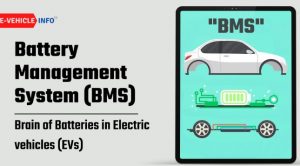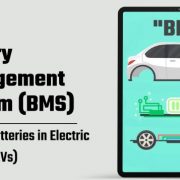Battery Management System: Brain Of Batteries in Electric Vehicles
By SUDHANSHU KUMAR -February 22, 2023

Battery Management System (BMS) is Brain for Batteries in EVs Electric Vehicles (EVs) are replacing conventional petroleum-based vehicles as EVs are less pollution-causing, and less operating cost is required. In Electric vehicles, the battery is used to power the motor (propulsion system) to drive the vehicle. The battery capacity is in the kWh range, so it is made of many small cells. Cells are connected in series-parallel combinations to meet the power required by vehicles. What is Battery Management System? BMS is an embedded system that comprises purpose-built electronics and custom designed algorithm to monitor and control information from sensors in the battery and maintain the battery in optimal use. Li-ion battery has a very high energy density and is very prone to short circuit so BMS is used to protect them. Battery Management System is used by all the EVs to protect the battery pack although it increases the cost of the vehicle and drains the battery to some extent.
It can be installed across cells in Centralised architecture(only one BMS for entire cells) and Distributed architecture(several BMS required as it is directly installed at the cells site). Why is the Battery Management System (BMS) required in Electric vehicles? As the battery is composed of several cells but not all cell work equally at all times. Electric vehicles (EVs) are a very dynamic load for battery (as vehicle acceleration/acceleration is not fixed) so some cells charge/discharged themselves faster than other cells which leads to the condition of over-charge or over-discharge. So BMS ensures the optimal use of the battery and protects the battery from the thermal runway (catching of fire). BMS continuously measures the state of charge (charge available to use) of the battery and tries to maintain all cells at the same level of charge this process is known as cell balancing. BMS Functions Apart from providing protection to cells, BMS also provides the following functions: Diagnostics It includes any abuse detection (can be external or internal eg loss of coolant, contractor failure), state of health (cell aging to date), and state of Life (predicts how much life remains). So if any cell stops working or catches fire must be cut off from the remaining battery pack. So that battery should continue its smooth functioning. Logbook It is done by the BMS for diagnostic and warrantee purposes of the battery. It stores information on the type of abuse (current, voltage), duration, and magnitude of abuse. It stores the data in memory which can be downloaded whenever it is required. It also keeps a record of the charge and discharge cycle to compare the performance of the battery with aging. Communication BMS communicates with the upper vehicle controller and the motor controller to ensure the proper operation of the vehicle. It can be done through the data bus or the CAN bus. It is used for monitoring performance, set system parameters by the host, log data for the battery. Volkswagen uses the NXP company battery management system for its ID models. Here is the list of the top five Battery Management Systems manufacturing companies
Source:Battery Management System: Brain Of Batteries in Electric Vehicles (e-vehicleinfo.com)




